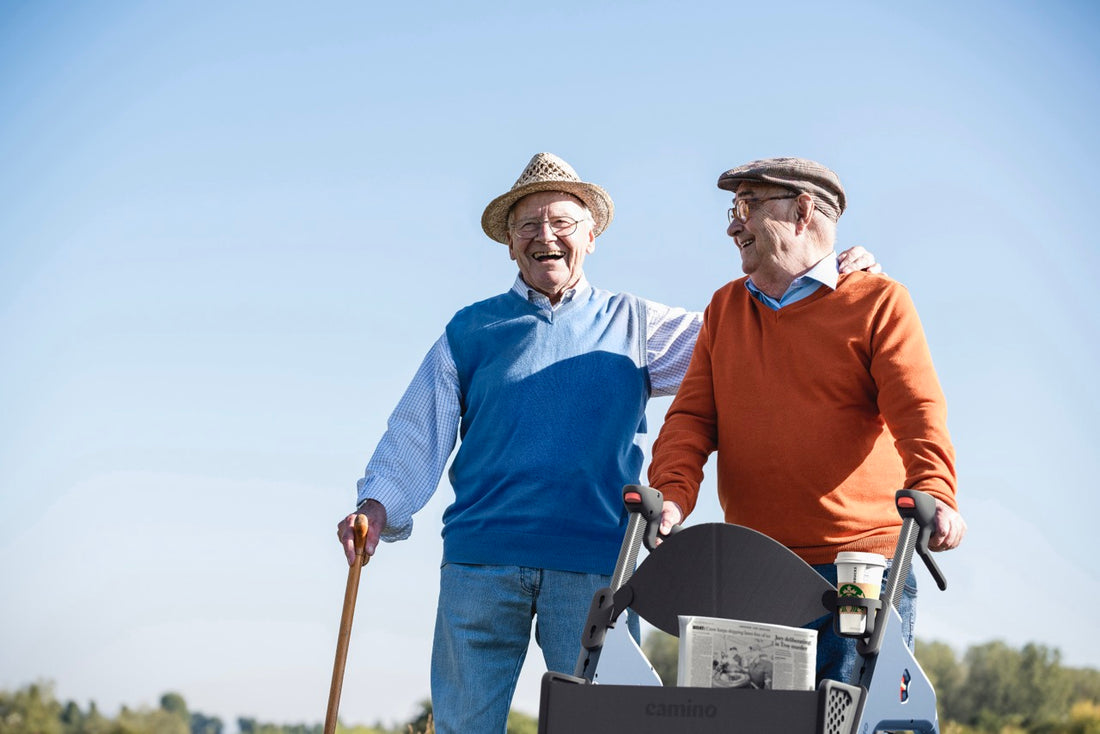How your walking habits can influence aging
Adopting good walking habits is a crucial part of aging well, maintaining overall health for seniors, and reducing fall risk. But is walking for seniors the best choice? Walking as an exercise for seniors is pretty perfect when you think about it: It's low intensity, readily accessible, easy to incorporate into your everyday life, and, unlike a gym membership, walking is completely FREE!
It's well-documented that regular, brisk walking provides a multitude of health benefits, particularly for older adults. In addition to these health benefits, regular walking can also provide opportunities for social interaction, contributing to improved quality of life and psychological well-being. It is important, however, to remember that the benefits of walking are closely tied to its frequency, duration, and intensity.

Five Ways Seniors Can Walk Better to Age Better and Reduce Fall Risk
We all know that walking is great for you, but science has revealed that walking's impact on your health is greater than you may have believed. We'll get into the science (it's pretty fascinating!), but first, here are five ways you make walking even better for senior health:
- Walk faster: Your walking speed significantly impacts senior health benefits derived from your walks.
- Walk farther: Walking farther is associated with decreased risk of death, by ALL causes.
- Walk frequently: By initiating a cycle of regular movement, risks associated with a sedentary lifestyle can be mitigated. Walking for two minutes every waking hour can have a positive impact on your health.
- Walk better: Improving the quality of your walk, step height or step symmetry may have a significant improvement in your balance, health, and fall risk.
- Use a walking aid: If appropriate, don't hesitate to use a walker or cane. Many people discover greater freedom when they take the step to adopt a walker. They find that they can walk faster, farther, and frequently, as well as meet friends and have fun. And dismiss the notion that walkers are clunky or ugly. Devices like the Camino Smart Walker are stylish, smart, and simple to use.
Read on as we break down the scientific evidence behind the five points above, and learn how walking well helps you age well. You'll also get easy tips on how to improve and maximize the benefits of your walks.
Before hitting the road, be sure to ask your doctor how to start a walking program for seniors, and read on to learn how to maximize the benefits of your walking routine.

Five Reasons Why Seniors Should Walk Faster To Age Well - The Evidence
In the context of aging well, one's gait speed significantly impacts the health benefits derived from walking. A faster walking pace, within an individual's comfort zone, is linked to numerous health advantages. Here are five evidence-based reasons to walk faster:
- Enhanced Cardiovascular Health: According to the CDC, increased walking speed has been associated with improved cardiovascular health. It helps in maintaining a healthy heart rate and blood pressure, thereby reducing the risks of cardiac diseases.
- Better Musculoskeletal Fitness: Walking at a brisk pace promotes the strengthening of bones and muscles. It aids in maintaining bone mineral density and muscle mass, both of which tend to decrease with age.
- Improved Balance and Coordination: A faster walk requires more coordination and balance, thus helping to enhance these crucial skills in older adults. This indirectly contributes to fall prevention.
- Optimal Weight Management: Higher walking speed, coupled with regular practice, contributes to increased energy expenditure, which can aid in weight management.
- Improved Mental Health: Regular brisk walking can boost mood and reduce the risk of mental health disorders. According to the Mental Health Foundation, "Even a short burst of 10 minutes of brisk walking increases our mental alertness, energy and positive mood."

How Seniors Should Improve Their Walking Speed
Despite the potential benefits, your increase in walking speed should be gradual. This approach ensures that individuals do not overexert themselves, thereby minimizing the risk of injuries. Be sure to consult with your doctor before making any changes to your activity level.
| Week | Recommended Speed Increase |
|---|---|
| 1-2 | 5% |
| 3-4 | 10% |
| 5-6 | 15% |
The table above offers a suggested approach to gradually increase walking speed over six weeks. This method allows for steady and manageable improvement, reducing the risk of injury and ensuring maximum health benefits.
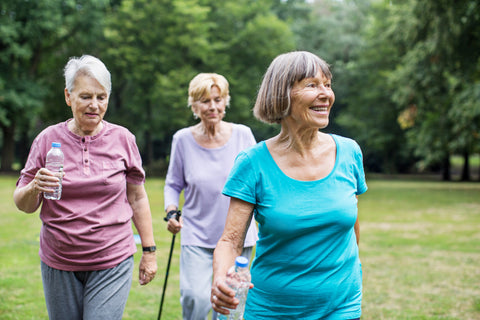
The Science:
A 2007 study was conducted to explore the relationship between one-year improvement in health and physical function and eight-year survival among 439 participants aged 65 and older. Researchers measured six markers of health and function in one year, including gait speed.
The study results revealed that improved walking speed was associated with increased survival rates. After 8 years, mortality was 31.6% for those with improved walking speed, 41.2% for those with transiently improved walking speed, and 49.3% for those who never improved. The survival benefit for improvement at one year persisted after adjusting for demographics, comorbidity, cognitive function, and hospitalization. This association was consistent across subgroups based on age, sex, ethnicity, initial walking speed, healthcare system, and hospitalization.
The study's findings suggest that increasing walking speed can lead to a decrease in mortality among older adults. As speed is easily measured, clinically interpretable, and potentially modifiable, it may serve as a useful "vital sign" for seniors. Further research is needed to determine whether interventions designed to improve walking speed can affect survival rates. Overall, this study provides strong evidence that enhancing walking speed can contribute to improved longevity for the elderly.

Walk Farther - The Benefits of Seniors Increasing Step Count
You've heard people talking about "getting their steps in," but how many more steps do you need to take to see some benefits? Physical activity, particularly walking, significantly helps maintain health and well-being in older adults, and there are scientifically-backed benefits for increasing walking distance. Walking is essentially a weight-bearing exercise, which can help in managing a healthy weight, increasing bone density, and enhancing cardiovascular fitness. By walking farther, seniors can amplify these benefits.
From a physiological perspective, walking farther or increasing your step count fortifies cardiovascular health, boosts respiratory efficacy, strengthens muscular function, and improves metabolism. It has also been found to be beneficial in the management of chronic diseases like hypertension, diabetes, and obesity. Here's the amazing part: Increasing steps is also associated with decreased risk of death, by ALL causes.

The Science:
A study was conducted to explore the association between the number of steps per day with all causes of death. The study included 47,471 adults, with data collected from 15 different studies (seven published and eight unpublished) conducted between 1999 and 2018. The participants were followed for a median of 7.1 years.
The results showed that taking more steps per day was associated with a progressively lower risk of all causes of death, up to a level that varied by age. The risk of mortality decreased progressively among adults aged 60 and older with increasing steps per day until 6,000-8,000 steps per day, and among adults younger than 60 years until 8,000-10,000 steps per day. The study concluded that taking more steps per day was associated with a progressively lower risk of death.
Increasing steps per day has been shown to reduce the incidence of cardiovascular disease (CVD), highlighting the importance of promoting walking to improve health outcomes. One study found that taking more daily steps was associated with a progressively decreased risk of CVD, particularly among older adults.
In a 24-week walking study, women who walked 3 km per day above their normal walking distance had significantly lower blood pressure.

A study presented at American Heart Association’s 2023 conference demonstrated that walking an additional 500 steps per day, or about one-quarter of a mile, was associated with a 14% lower risk of heart disease, stroke, or heart failure in people aged 70 and older. Adults who took approximately 4,500 steps per day had a 77% lower risk of experiencing a cardiovascular event compared to those who took less than 2,000 steps per day.
Walk Better -How Improving Gait Helps Seniors Age Well and Reduce Fall Risk
Walking helps to preserve balance and coordination, reducing the risk of falls in older adults. The best way to take advantage of these benefits is to refine the way you walk (your gait) to optimize comfort and safety.
Seven Ways For Seniors To Walk Better, Age Well, and Reduce Fall Risk
Here are seven tips for seniors to walk safely to make sure you get off on the right foot.
- Warm Up: Starting with a slow walk and gradually increasing the pace can help prepare the body for physical activity and reduce the risk of injuries.
- Wear the Right Shoes: Appropriate footwear plays an instrumental role in promoting safer and more stable walking. Look for shoes that fit well and have non-slip soles.
- Check Your Posture: Maintaining an upright posture with the head up and shoulders back can improve balance and prevent strain.
- Stay Hydrated: Drinking plenty of water before, during, and after the walk helps prevent dehydration, particularly in warmer weather.
- Maintain Consistency: It is imperative to establish a routine that involves walking on a daily basis. This consistency aids in improving muscle strength and balance.
- Switch Up Your Terrain: One should attempt to walk on different surfaces such as grass, gravel, and pavement. This variety aids in enhancing balance and adaptability.
- Try Physical Therapy: If you and your doctor decide that physical therapy would be helpful in improving your gait, it can significantly contribute to improved mobility, balance, and coordination, thereby enhancing your walking capabilities.
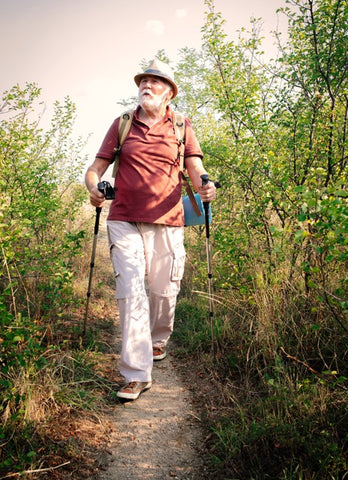
The Science:
A 2009 study measured baseline gait assessment in 597 adults aged 70 and older. The study then tracked whether patients fell in the following months. Over a follow-up period of 20 months, 226 (38%) of the 597 participants fell. Researchers found:
- A 10% increase in stride length variability was associated with an 8% increase in all fall types risk and a 13% increase in injurious fall risk (laceration, fracture, or received emergency care).
- A 10 % increase in swing phase proportion (the part of walking during which the foot is not touching the ground) was associated with a 40% increase in falls.
- A 10% increase in the double-support phase ( When both feet are in contact with the floor at the same time during a walk) was associated with a 17% increase in falls.
- A 10 cm/s decrease in speed was associated with a 7% increase in falls.
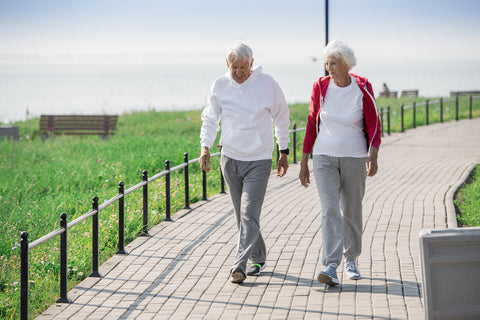 Walk Frequently
Walk Frequently
It is imperative to understand the significance of frequent movement, particularly walking, in the daily routine of seniors. Maintaining an active lifestyle is a crucial factor in the prevention of various health issues commonly associated with aging, such as obesity, cardiovascular diseases, and diabetes. Even the habit of walking every hour for a period of two minutes can result in notable health benefits.
Regular movement, such as walking, has been identified as a practical strategy to interrupt the sedentary cycle. Sedentariness, characterized by prolonged periods of inactivity, is a significant risk factor for falls and other health complications among seniors. By initiating a cycle of regular movement, the inherent risks associated with sedentary behavior can be effectively mitigated.

Four Benefits of Frequent Walking

Engaging in frequent walking provides several health benefits for seniors. Some of these benefits include:
- Enhanced Mobility: Regular walking can significantly improve gait and balance, thereby reducing the risk of falls and associated injuries.
- Improved Cardiovascular Health: Walking aids in maintaining a healthy heart rate and promotes cardiovascular health, thereby reducing the risk of heart diseases.
- Promotion of Healthy Weight: Engaging in regular walking helps in managing body weight, which is crucial in preventing obesity-related complications.
- Better Digestion: Movement after meals aids in digestion and prevents gastrointestinal complications.
Incorporating frequent walking into a daily routine can not only enhance overall health but also promote a sense of well-being among seniors. Therefore, it is highly recommended for seniors to break the sedentary cycle and engage in regular bouts of walking throughout the day.
The Science:
Engaging in physical activity, particularly walking, following meal consumption has been identified as a beneficial strategy in managing blood sugar levels, thereby potentially reducing the risk of type 2 diabetes. This assertion is supported by numerous scientific studies that have consistently emphasized the importance of physical activity in maintaining optimal health in seniors.
One such study, conducted by researchers at George Washington University, revealed that elderly individuals who engaged in a brief walk following every meal exhibited significantly lower levels of blood sugar compared to those who did not engage in such activity. The research, published in the journal Diabetes Care, serves as a testament to the impact of walking on blood sugar regulation.
The aforementioned study recommends a brief walk of approximately two minutes following each meal. This duration, though seemingly insignificant, has been scientifically proven to induce a substantial reduction in blood sugar levels.
Walk For Your Brain
 Don't overlook the mental health benefits of walking! Walking plays a pivotal role in maintaining emotional stability and reducing symptoms of anxiety and depression. Increasing walking distance has also been linked with improved cognitive function and reduced risk of neurodegenerative disorders. Research indicates that walking can reduce the likelihood of cognitive impairment, lower dementia rates in elderly adults, and alleviate sundowning behavior in Alzheimer's patients.
Don't overlook the mental health benefits of walking! Walking plays a pivotal role in maintaining emotional stability and reducing symptoms of anxiety and depression. Increasing walking distance has also been linked with improved cognitive function and reduced risk of neurodegenerative disorders. Research indicates that walking can reduce the likelihood of cognitive impairment, lower dementia rates in elderly adults, and alleviate sundowning behavior in Alzheimer's patients.
The Science:
A systematic review of 20 studies found that walking correlated with better cognitive function, including memory, executive function, and processing speed in older adults. Another study involving 75,000 UK adults suggested that around 9,800 steps per day optimally lowered dementia risk, with a minimum of 3,800 steps reducing incident dementia by 25%.
A third study found that walking for 30 minutes, three times a week, for six months improved cognitive function in older adults with mild cognitive impairment (MCI).
Still, another study focused on walking's effects on sundown syndrome, a significant care issue for dementia patients and their caregivers. The study revealed that walking 30 minutes a day, four times a week, reduced sundown syndrome in Alzheimer's patients. Both morning and afternoon walking were effective.
Walking has been consistently shown to improve mental health, as supported by the findings of the following studies. One study focuses on the relationship between leisure-time physical activity (LTPA), walking, and mental health in older women. The study assessed data from 6,653 women aged 73-78, and found that even low levels of walking are associated with lowered depression and anxiety symptoms. The lowest scores were observed in women reporting high levels of walking, suggesting a strong link between walking and improved mental health in older women.
Another study investigated the associations between daily pedometer steps, health-related quality of life (HRQoL), and psychosocial health among men aged 55 and older. The study revealed that participants with higher daily step counts reported fewer depressive symptoms and better HRQoL compared to those with lower step counts. This suggests that increasing step counts among older adults is a meaningful target for improving HRQoL and psychosocial health.
Walk With Camino Smart Walker.
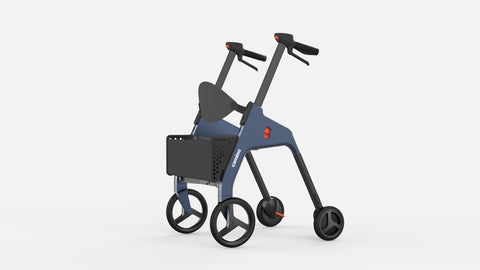
People tend to get walkers or canes after an unfortunate incident has transpired, when earlier adoption of a walking aid may have prevented the incident in the first place. This is due to a pervasive societal stigma associated with the use of such mobility aids, leading many individuals to delay getting a walker or cane until it is arguably too late.
However, this need not be the case. The utilization of a walker does not need to be a symbol of frailty, but rather, a tool for enhanced mobility and independence, especially for senior citizens. It is an instrument that can open up new horizons for its users, facilitating their participation in activities they might have otherwise found challenging.
Furthermore, walkers are no longer the drab, clinical devices they once were. In recent years, there has been a surge in the production of stylish and aesthetically pleasing designs, demonstrating that practicality and style are not mutually exclusive. The modern walker can serve as a reflection of one's personal taste, further breaking down the stigmatization associated with its use.
Ultimately, the decision to use a walker should not be driven by societal perception, but by the potential benefits it offers to the individual. By enhancing mobility, it contributes significantly to the prevention of falls, a prevalent concern among the elderly population. It is a proactive step towards maintaining good health and promoting active aging.
Many different mobility devices are geared toward seniors, but the Camino Smart Walker stands out as a particularly beneficial tool. Its design and functionality cater to the needs of older adults, thus providing them with the necessary support to walk independently and securely. Check out some of Camino's features below:
| Feature | Description |
|---|---|
| Adjustable Handles | These allow for the walker to be adjusted to the individual's height, promoting posture correctness and reducing the risk of back pain that could result from hunching over. |
| Automatic Brakes | Equipped with an automatic braking system, the Camino Smart Walker provides the user with full control, thus preventing unwanted movement and possible falls. |
| Auto-Boost | A gentle boost along flats and up hills makes Camino easy to handle. No pushing means walking tall and less tiredness. |
| Smart Technology | Camino can monitor the user’s gait, speed, and balance, providing valuable data that can assist caregivers and health professionals in assessing and optimizing the user’s walking performance. |
The Camino Smart Walker not only facilitates walking faster, farther, and more often, but also fosters a sense of independence among older adults. With its advanced technology and ergonomic design, it's a substantial aid in maintaining an active lifestyle while preserving safety and comfort.
For more information about the Camino Smart Walker and to try one out for yourself, visit CaminoMobility.com.


